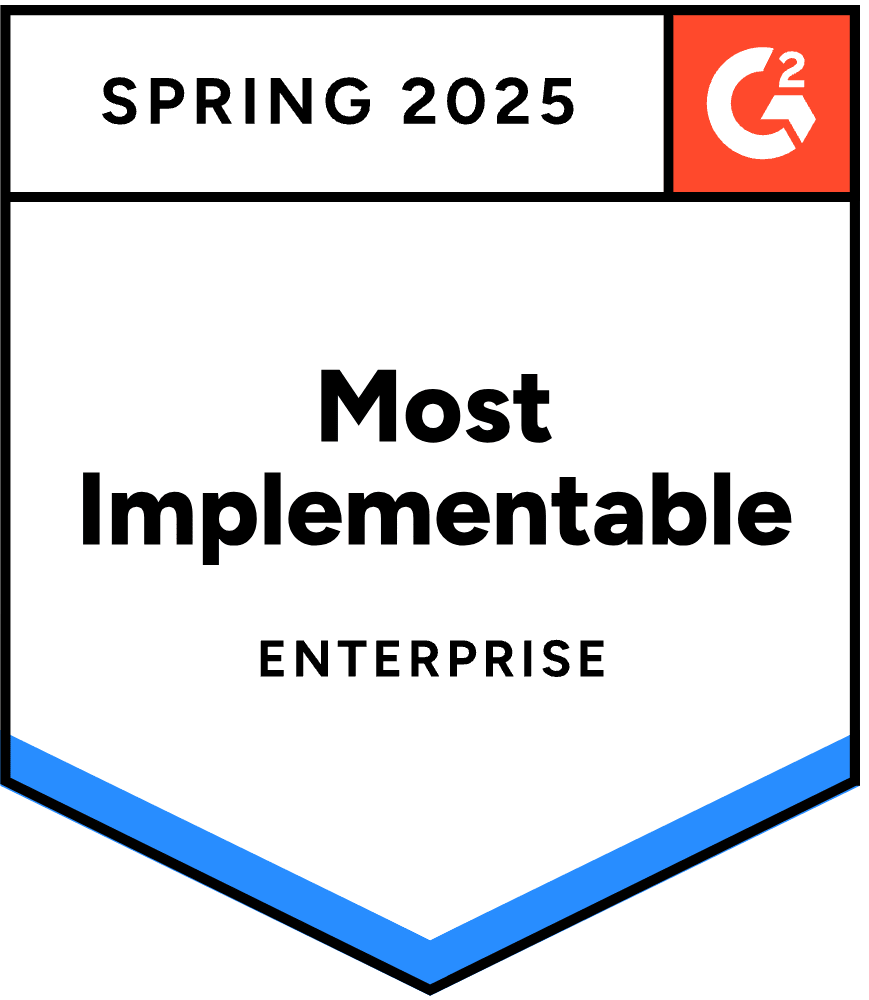Sales CMS Guide: What is a Sales Content Management System?
Anna Spooner | WorkRamp Contributor
View bioLearning Tips Straight to Your Inbox
A sales content management system or sales CMS helps enablement, marketing, and other teams organize high-value content assets so they’re easy to find.
Sales reps use these assets to answer customer questions, show how your product or service meets their needs, and overcome objections. The right content helps the buyer see the benefits of your solution, and a sales CMS puts the content where reps can find it.
Sales reps have an average of 1,400 assets to choose from during the sales process. But so many types of content can limit the impact of each piece. As a result, sales reps struggle with information overload, redundancy, and poor asset management.
When you have the right sales content management system, however, you can organize sales assets, ensure you aren’t recreating content you already have, and more. In addition to making the most of your sales enablement content, a sales CMS can help your reps feel ready for anything they may encounter during the sales cycle.
In this post:
What is a sales CMS (sales content management system)?
A sales CMS is software that allows your teams to manage the creation, storage, organization, and delivery of sales materials.
This process is part of sales enablement, and a unified CMS + LMS solution, like the Learning Cloud from WorkRamp, includes both the content management and LMS functions your organization needs.
Sales CMS Example
Handshake, a leading college career network, used WorkRamp to create new hire onboarding and training, along with a variety of sales enablement training, which they deploy in a remote work environment.
The fully virtual environment adds to the challenge of managing ramp time, increasing revenue, and increasing average deal size. The team used WorkRamp to create Handshake U, allowing the company to centralize its onboarding, new hire training, and sales enablement content. With WorkRamp, Handshake has visibility into how new reps perform on initial training projects, allowing trainers to work with struggling employees. This has reduced ramp time by 33 percent.
At the same time, Handshake uses WorkRamp to train tenured AEs and organize their sales content, ensuring it’s always available when reps need it. This accessibility and continuous learning have allowed Handshake to double year-over-year revenue and increase average deal size by 15 percent.
As you can see, a platform that allows you to organize and leverage sales content can make a significant difference in your organization’s results.
Why is a sales CMS important?
Making a sale in today’s marketplace requires the right content, whether it’s case studies, videos, one-pagers, infographics, or other information.
However, this process relies on your sales reps finding the right materials at the right time. Unfortunately, 65 percent of sales reps say they can’t find meaningful content to share with leads and prospects, and even more don’t use sales materials because they are out-of-date, irrelevant, or too hard to customize for the buyer’s needs.
In short, sales content management allows your company to store, manage, and organize content that sales reps use to promote your products and services.
Benefits of a sales content management systems (CMS)
One of the biggest advantages of a sales CMS is that it sets your reps up for success. When they have the right materials during the sales process, they come off as professional consultants rather than pushy salespeople.
The necessary materials are vital since B2B buyers want more content at every level. Among B2B buyers, 55 percent say they rely more on content for buying decisions than in years past, and B2B content consumption has increased by nine percent.
There are a variety of other benefits to a sales CMS as well.
Shorter sales cycles
When your sales reps can find the right information, they can move prospects through the sales process quickly. On the other hand, if they have outdated assets or, worse, don’t use the content you create, the sales process will take longer, and the close rate will be significantly lower.
By ensuring reps have the right information, you can improve sales conversations, resulting in faster sales and higher quota attainment rates.
More content usage
As we mentioned, many sales reps report frustration because they can’t find meaningful sales enablement content to share with leads or the content they have is outdated or irrelevant.
Using a sales CMS helps address those concerns. Reps can find the content they need, and the marketing team can also keep up on what assets need to be updated or adapted to the current sales process.
When marketing assets are easy to find, relevant, and up-to-date, sales reps will be far more likely to use them. That means the hard work, time, and money spent on creating those assets won’t be wasted—instead, it will generate positive ROI.
Better sales rep productivity
One study found that sales reps use up to 440 hours each year looking for the right content for prospects. That’s 20 percent of their working hours.
Imagine giving your reps a 20 percent improvement in productivity—that’s what an effective content management system can do.
Read more: 6 Ways to Improve Sales Efficiency
Consistent brand messaging
When sales and marketing assets are spread across multiple systems, it’s easy for some of those materials to not match the company’s current branding guidelines. Whether it’s misformatted, includes terms you no longer use, or has an old logo or color scheme, marketing materials that don’t match your brand can confuse leads.
Having all current marketing materials in a sales CMS means it’s easy for the marketing team to keep everything consistent regarding messaging, brand layout, and more. Sales reps can have confidence that the materials they use from the CMS will be the most persuasive, on-brand messaging available.
Improvements in sales enablement
It’s not just reps who benefit from a sales CMS—your enablement team does as well. With the right tool, you can help guide content strategy to match the sales team’s needs, avoid duplicate work, and ensure outdated content and misinformation are not shared with prospects.
Keeping everything up-to-date in a sales CMS saves you time, money, and headaches.
Personalized buyer experiences
A sales CMS helps ensure that the marketing materials reps have access to are easy to personalize to a lead’s specific needs. Personalized marketing can help speed up the sales process and provide engaging, useful content to decision-makers.
McKinsey recently found that 72 percent of consumers expect businesses they buy from to treat them as individuals and understand their needs. These consumers don’t go to work at B2B companies and forget those needs. They also expect the same treatment as B2B buyers and organizations that deliver are far more likely to win the deal.
Implement a sales CMS
Step one, of course, is to find a high-quality sales CMS. For example, WorkRamp CMS allows you to create and deploy sales enablement and training on a single platform while making it easy to create sales assets, organize them, and make them available to sales reps.
The intuitive, easy-to-use system makes it simple to create and manage assets and training for your sales team.
Provide the right sales content
What types of content do you want to store and organize in your content management system? There are many answers, and you might be tempted to say, “All of it!”
However, it’s helpful to think about the kinds of content that help your sales reps the most when interacting with customers:
- Case studies
- One-pagers
- White papers and eBooks
- Email content templates
- Customer success stories
- Videos
- Infographics
These types of sales enablement content should be stored and organized in your sales CMS.
Work with your sales team
Understanding what your sales team needs is a core part of an effective sales enablement strategy. Talk to reps and find out their primary concerns when it comes to finding the right sales materials at the right time.
Then, use a unified CMS + LMS, like WorkRamp, to address those problems. That might mean improving sales training, creating playbooks on how to use sales materials effectively, and creating and organizing content so that everyone can quickly find what they need.
Track and analyze content use and effectiveness
The best way to know if your organization is successful in maximizing your sales content is to track how it’s used and how effective the assets are in driving results.
When you know how sales content is (or isn’t) being used, you can address roadblocks. Also, if you find out from reps that certain assets are especially helpful, you can double down on creating that kind of content to improve the efficiency of the sales process.
Sales content management system functionalities
As you look at implementing a sales CMS, knowing what features to look for is important. Having these features will help ensure that the platform will help you effectively manage sales content.
Organizing and sharing content
If a system doesn’t allow you to share and organize content, it probably isn’t a content management system! This is the essential function that you should look for first.
Of course, not all organizational and sharing systems are equal. You’ll want one that’s easy to use for content creators and sales reps who need to access sales assets. That way, the marketing team can ensure everything is branded correctly, relevant, and updated, and the sales reps can get what they need quickly to share with leads.
Lead nurturing and engagement
The right sales content is essential for nurturing and engaging leads throughout the customer journey. By tailoring content to address specific needs and pain points, sales teams can establish meaningful connections with prospects.
Having a sales CMS where you can easily create, store, and deploy sales content helps teams work more efficiently.
File type support
A solid platform for sales training and content management needs to support various file types. For example, sales content might be Word documents, Google docs, PDF files, image files of various types, videos, or audio files.
When looking at different platforms, make sure that your team can store, organize, and easily access various files within the CMS—and, even better, that these same file types can be included in training created as part of your organization’s learning culture.
Easy content updating
Given that out-of-date materials are one of the key complaints reps have about sales content, having a sales CMS that makes it easy for marketers to update assets regularly is essential.
How easy a system is to use will determine whether the content is updated promptly or the task is put off indefinitely. Ensure that the people in your company updating sales content vet the CMS before you invest and give you honest feedback about ease of use.
User permission management
Having specific permissions for accessing content can be important in highly regulated industries. Some materials may also need to not be changed or updated to comply with specific legal or brand requirements.
As a result, being able to manage user permissions and give different levels of access to different people is an important feature to look for. However, remember that most sales materials should be editable so that sales reps can customize them to fit the specific needs of their leads.
Integration opportunities
Finally, it’s important for all of your technology to connect seamlessly. As you consider sales CMS options, consider which integrations you might need. For example, you might want to connect the CMS to your sales CRM, to the HR platform, or communication and scheduling software.
It’s important to understand what integrations are available and how easy they are to connect and maintain before you choose a solution.
Sales CMS limitations
If you choose the wrong sales CMS, you can run into frustrating problems and limit the effectiveness of your sales materials.
Limited integrations
If you can’t connect other parts of your technology stack to the sales CMS, you aren’t going to get full functionality from the system. For example, being unable to connect the CMS to your CRM means you won’t know how sales materials are used in the sales process.
Fortunately, WorkRamp offers various integrations across multiple categories, including HR, communications and scheduling, sales and support systems, and more.
Lack of user permission control
If you can’t set specific user permissions within the CMS, keeping your sales content on-brand, legally compliant, and accurate can be challenging.
While most sales content should be customizable so reps can personalize it to the lead’s unique situation, some documents may need to be locked for brand, regulatory, or compliance reasons. Being able to carefully manage user permissions allows your company to maximize the different types of content in the CMS.
WorkRamp makes it easy to set specific permissions for each user.
Problems with ease of use
As mentioned above, if a CMS is hard to use, your team members will avoid using it.
A platform like WorkRamp is easy to use and makes updating content quick and effortless. Best of all, it can be accessed wherever your employees are, whether using a mobile device or a laptop. A straightforward CMS will maximize its usefulness for all team members.
How to use a sales content management system
At a high level, a sales CMS is designed to help you organize your sales content so your reps can easily find what they need. It also helps your sales enablement team understand what content already exists so you can work on updates and new materials.
1. Make sure all content has a clear goal
The content in your sales CMS should work as hard as your sales reps do, which means each piece has a clear purpose and goal. These goals will be related to where the lead is in the sales process and what you need to move them forward.
Demand Gen’s 2022 Content Preferences report found that buyers were only interested in spending 5 to 30 minutes on content, so consider that as you build your sales materials.
2. Identify the target audience for each sales asset
Many companies have multiple target audiences, and your sales reps need to know exactly what content to use for which prospects. If your sales team has to dig through a lot of irrelevant content, they likely won’t use it.
Your sales CMS can make it easy to divide content by lead type, so your sales team will have no problem finding exactly what they need without reworking content intended for an entirely different audience.
3. Categorize sales materials based on the sales stage
Along with organizing content by lead, be sure to categorize your sales assets based on what part of the sales process they are in. For example, you might have folders for each stage, so a sales rep only needs to open that folder to find everything relevant to that sales stage.
Have content that could serve multiple purposes? Some CMSs let you tag multiple stage labels for a single asset. Doing this takes the guesswork out for your reps.
4. Measure the results of sales content
Finally, you’ll want to ensure that all sales content is effective. You can talk to sales reps, measure results when specific assets are used, and get customer feedback to determine which materials matter most in their decisions.
These results can help you update or improve sales assets as needed. Or, you might discover that one asset isn’t doing what you anticipated and needs to be removed from the process.
5. Update and create new content as needed
Your sales content is never done—there is always more content to create, update, and improve.
By understanding where in the sales process you need more support vs. what pieces are doing well, you can determine where to focus your efforts.
More about sales CMS
Many organizations have additional questions about what a CMS is and how it compares to other systems.
Let’s take a look at some frequently asked questions.
Sales CMS vs. sales LMS
Both a CMS and a learning management system (LMS) store vital information for your sales teams but have different focuses.
- A CMS generally has externally focused information—sales materials to share directly with prospective customers
- An LMS is generally focused on your company. It includes learning modules on ideal customers and needs, career development for current team members, and sales best practices reps can use to improve their results. Many companies also use their LMS to create customer education and certification programs to improve customer retention and help users get the most out of their investments.
With the Learning Cloud, you get both benefits by offering a single CMS + LMS solution. This allows you to support your sales teams in two ways: with excellent support and training and with the right sales assets for prospects.
You can embed assets into training courses, instruct sales teams on how to use the sales assets appropriately and at what stage in the sales cycle, run knowledge checks, and test pitches.
Sales CMS vs. sales CRM
A sales customer relationship management (CRM) tool allows your company to track leads and prospects, know where they are in the sales process, send email marketing, and more.
On the other hand, a CMS is where you place materials that are helpful for reps during the sales process. You can store and organize your content so it’s easy to find and use at the right time.
A CRM is occasionally called a CMS when the acronym means customer management system, but a CRM and a content management system are very different.
Because a CMS and CRM have different functions, you should use both. For example, it’s essential to store information from leads and customers, track interactions, and understand where leads are in the sales cycle.
However, you must also ensure that your sales materials are up-to-date, organized, and easy for sales reps to find when necessary. When sales reps don’t have to rely on their inboxes or Google Drive to store materials, they’ll be much more likely to use the right assets at the right time.
Best sales CMS training
When you have a single platform that allows you to manage sales onboarding, train existing reps on best practices and new sales strategies, and organize your sales content all in one place, you’ve found a multifunctional platform that will help your organization excel.
WorkRamp CMS makes it easy to manage and update sales assets, create training courses for your sales team, and use multiple types of information to ensure that training and sales assets are engaging, informative, and useful.
Top sales CMS courses
If you want to learn more about how to use sales content to its full potential, as well as how to implement sales enablement strategies and improve close rates, quota attainment, and employee engagement, there are a variety of resources available.
Online courses
Additional resources
- WorkRamp blog: Read the latest trends in sales training, content management, and sales enablement
- LEARN podcast: Hear from top leaders in tech
- Videos: Actionable insights from leading experts
- Webinars: The latest information from sales enablement leaders
Improve your sales CMS
Forrester found that 65 percent of content created by a B2B organization isn’t used because it’s either unfindable or unusable.
Don’t let your sales enablement content go to waste. Instead, get the tools you need to help your sales reps excel. A unified sales CMS + LMS like WorkRamp can help your reps be well-equipped and well-trained, giving them the best chance to help your business grow. Join the waitlist to be notified when WorkRamp CMS is available.
Ready to learn more about how WorkRamp can help you equip your sales team with training to drive revenue performance and close more deals? Contact us for a free, personalized demo.
Complete the form for a custom demo.
Recent Posts
- Why Secure LMS Platforms Are a Must for Regulated Industries July 10, 2025
- Top LMS Integrations That Power Smarter, Faster Learning July 2, 2025
- Introducing WorkRamp Analytics Studio: Unlocking Your Data Insights with AI June 30, 2025
- 11 AI LMS for AI-Powered Learning June 27, 2025
- The Best LMS Platforms for Customer Retention (2025 Guide) June 27, 2025
Anna Spooner
WorkRamp ContributorAnna Spooner is a digital strategist and marketer with over 11 years of experience. She writes content for various industries, including SaaS, medical and personal insurance, healthcare, education, marketing, and business. She enjoys the process of putting words around a company’s vision and is an expert at making complex ideas approachable and encouraging an audience to take action.
You might also like
Enablement trends to keep top-of-mind
Learn more about where the enablement landscape has been—and, more importantly, where it’s headed.
Read More
How to find the right team members and resources to create a successful enablement program
Organizations with a dedicated sales enablement function have significantly better win rates, quota attainment, and customer retention. Learn how to build a successful enablement team.
Read More
6 Sales Onboarding Best Practices
Take your onboarding to the next level using these sales onboarding best practices from enablement leaders at WorkRamp, Divvy, Zoom, and Handshake.
Read More
Decrease Ramp Time and Increase Revenue
Get in touch to learn how WorkRamp can help you achieve your learning and development goals.
Request a Demo




